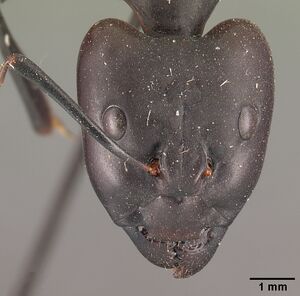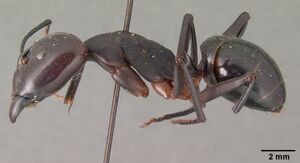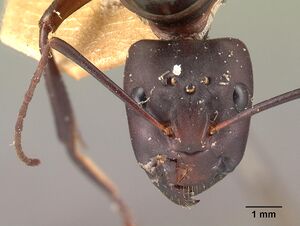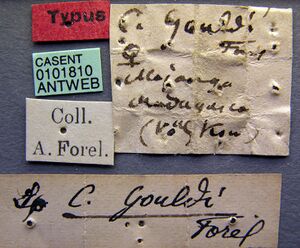Camponotus gouldi
| Camponotus gouldi | |
|---|---|

| |
| Scientific classification | |
| Kingdom: | Animalia |
| Phylum: | Arthropoda |
| Class: | Insecta |
| Order: | Hymenoptera |
| Family: | Formicidae |
| Subfamily: | Formicinae |
| Tribe: | Camponotini |
| Genus: | Camponotus |
| Subgenus: | Myrmosaga |
| Species: | C. gouldi |
| Binomial name | |
| Camponotus gouldi Forel, 1886 | |
The dry forest of the west, the spiny forest and thicket of the southwest, the transitional humid forest in the PN Andohahela, the savannah shrubland and woodland, and the Uapaca woodland and montane rainforest of the south-central high plateau of Madagascar are all habitats where C. gouldi occurs. This species nests mostly in rotten logs, in the ground, and under stones, rarely in rotting tree stumps and rotten sticks. Workers forage most often on the ground and seldom on lower vegetation.
Identification
Rakotonirina and Fisher (2022) - With head in full-face view, lateral margins of head anterior to eye level parallel and lacking erect hairs, posterior portion of head extending into a neck and anteromedian clypeal margin continuously forming broad convexity; dorsal outline of mesosoma broadly convex; body color black to dark brown.
Camponotus gouldi is mostly similar to Camponotus aro, but the posterior portion of the head for the latter is normally rounded, not extending into a short neck, and the propodeal dorsum immediately posterior to the metanotal groove is convex, then becomes concave medially and rounds to the declivity surface.
Keys including this Species
Distribution
Latitudinal Distribution Pattern
Latitudinal Range: -20.06666667° to -25.5944°.
| North Temperate |
North Subtropical |
Tropical | South Subtropical |
South Temperate |
- Source: AntMaps
Distribution based on Regional Taxon Lists
Malagasy Region: Madagascar (type locality).
Distribution based on AntMaps
Distribution based on AntWeb specimens
Check data from AntWeb
Countries Occupied
| Number of countries occupied by this species based on AntWiki Regional Taxon Lists. In general, fewer countries occupied indicates a narrower range, while more countries indicates a more widespread species. |

|
Estimated Abundance
| Relative abundance based on number of AntMaps records per species (this species within the purple bar). Fewer records (to the left) indicates a less abundant/encountered species while more records (to the right) indicates more abundant/encountered species. |

|
Biology
Castes
Worker
Images from AntWeb=
   
| |
| Worker (major/soldier). Specimen code casent0101850. Photographer April Nobile, uploaded by California Academy of Sciences. | Owned by MHNG, Geneva, Switzerland. |
Queen
Images from AntWeb=
   
| |
| Queen (alate/dealate). Specimen code casent0101810. Photographer April Nobile, uploaded by California Academy of Sciences. | Owned by MHNG, Geneva, Switzerland. |
Nomenclature
The following information is derived from Barry Bolton's Online Catalogue of the Ants of the World.
- gouldi. Camponotus egregius r. gouldi Forel, 1886c: civ (s.) MADAGASCAR.
- Type-material: neotype major worker (by designation of Rakotonirina & Fisher, 2022: 87).
- Type-locality: neotype Madagascar: Mahajanga, P.N. Ankarafantsika, Forêt de Tsimaloto, 18.3 km. 46° NE Tsaramandroso, -16.22806, 47.14361, 135 m., 2-8.iv.2001, BLF03563 (B.L. Fisher, C.E. Griswold & Malagasy Arthropod Team).
- [Note: original type-data: holotype major worker Madagascar: (no further data) (A. Grandidier); depository unknown, holotype could not be found by Rakotonirina & Fisher, 2022: 87.]
- Type-depository: CASC (neotype).
- [Also described as new by Forel, 1886f: 167.]
- [Camponotus gouldi Forel, 1879a: 115. Nomen nudum.]
- Forel, 1897c: 210 (w.q.); Forel, 1907g: 90 (m.).
- Combination in C. (Myrmogigas): Forel, 1912i: 91;
- combination in C. (Dinomyrmex): Forel, 1914a: 268;
- combination in C. (Tanaemyrmex): Emery, 1925b: 85;
- combination in C. (Myrmosaga): Rakotonirina & Fisher, 2022: 87.
- Subspecies of egregius: Forel, 1891b: 22.
- Subspecies of angusticollis: Emery, in Dalla Torre, 1893: 221 (footnote), 233.
- Status as species: Dalla Torre, 1893: 233; Emery, 1896d: 370 (in list); Forel, 1897c: 201; Forel, 1904b: 377; Forel, 1907g: 90; Wheeler, W.M. 1922a: 1043; Emery, 1925b: 85; Bolton, 1995b: 102; Rakotonirina & Fisher, 2022: 87 (redescription).
- Distribution: Madagascar.
Unless otherwise noted the text for the remainder of this section is reported from the publication that includes the original description.
Description
Worker
Rakotonirina and Fisher (2022):
Morphological measurements: see Appendix 1 and Ratios of morphometric data for majors and minors
Minor In full-face view, head sides anterior to level of eye approximately parallel; lateral cephalic margins posterior to level of eye converging posteriorly and projecting into short neck; eye medium (EL/CS: 0.24±0.01; 0.23–0.26), protruding, and breaking lateral cephalic border, level of posterior margin located approximately at posterior 1/3 of head (PoOc/CL: 0.29±0.02; 0.26–0.32); frontal carinae more or less wide posteriorly (FR/CS: 0.26±0.01; 0.25–0.27), the same width as its smallest distance to eye; clypeus without anterolateral angle, anteromedian margin broadly rounded, mandible with two apical teeth distantly spaced; antennal scape relatively long (SL/CS: 1.56±0.06; 1.44–1.66). Mesosoma presenting even convexity; promesonotum strongly convex, posterior portion of mesonotum flat immediately anterior to weakly visible metanotal groove; propodeal dorsum almost flat, its junction to declivity bluntly angulate; propodeal dorsum 3 × as long as declivity. Petiole nodiform, with dorsal margin inclined posteriorly, forming a blunt angle to anterior margin, medially excised at the junction to posterior margin, anterior face 1/2 height of posterior face, which is inclined anteriorly to the dorsum; femur of hind leg rounded axially, not twisted basally.
First and second gastral tergites without a pair of white spots; lateral margin of head without erect hairs; erect hairs lacking near the end of neck; antennal scape without suberect hairs and covered with short appressed hairs; pronotum with a pair of erect hairs; posterodorsal angle of propodeum without erect hairs.
Major Characteristics the same as minor worker, except the enlarged head (CS: 5.19±0.23; 4.89–5.51; CWb/CL: 0.98±0.01; 0.97–1.00), which has no prolonged neck; the more strongly built mandible; antennal scape not extending beyond posterior cephalic margin; promesonotum convex; metanotal groove visible; propodeal dorsum feebly sloping towards declivity, its length the same as the height of declivity; petiolar node compressed anteroposteriorly.
Type Material
- Holotype (by monotypy) major worker, Madagascar (Grandidier) [not examined, type not found, Rakotonirina & Fisher, 2022].
- Neotype major worker, designated by Rakotonirina & Fisher, 2022: 87. MADAGASCAR: Province Mahajanga: PN Ankarafantsika, Forêt de Tsimaloto, 18.3 km 46° NE de Tsaramandroso, -16.22806, 47.14361, 135 m, tropical dry forest, ground nest, 2–8 Apr 2001 (Fisher, Griswold & Malagasy Arthropod Team) collection code: BLF03536, specimen code: CASENT0437531 (CAS).
Neotype designation was made by Rakotonirina & Fisher (2022) for C. gouldi because its type is presumed lost. No type specimen could be found at the renowned museums in Europe that might have held the specimen. One of the author BLF visited the Forel collection at MHNG, MNHN, NHMB, and MSNG and could not find the type for C. gouldi. Also, the type specimen appears to be absent from the little-known collection of Forel types at Naturmuseum Solothurn (Germann 2017). Morphological characters that define the designated neotype are in accordance with the original description of the former holotype specimen. Since the original type locality was not precisely located within Madagascar, the new locality type has been chosen on the basis of where the species was most often collected across its geographical distribution.
References
- Dalla Torre, K. W. von. 1893. Catalogus Hymenopterorum hucusque descriptorum systematicus et synonymicus. Vol. 7. Formicidae (Heterogyna). Leipzig: W. Engelmann, 289 pp. (page 233, Raised to species)
- Emery, C. 1925d. Hymenoptera. Fam. Formicidae. Subfam. Formicinae. Genera Insectorum 183: 1-302 (page 85, Combination in C. (Tanaemyrmex))
- Forel, A. 1886c. Diagnoses provisoires de quelques espèces nouvelles de fourmis de Madagascar, récoltées par M. Grandidier. Ann. Soc. Entomol. Belg. 30:ci-cvii. (page civ, soldier described)
- Forel, A. 1897d. Ameisen aus Nossi-Bé, Majunga, Juan de Nova (Madagaskar), den Aldabra-Inseln und Sansibar, gesammelt von Herrn Dr. A. Voeltzkow aus Berlin. Mit einem Anhang über die von Herrn Privatdocenten Dr. A. Brauer in Marburg auf den Seychellen un (page 201, Raised to species)
- Forel, A. 1897d. Ameisen aus Nossi-Bé, Majunga, Juan de Nova (Madagaskar), den Aldabra-Inseln und Sansibar, gesammelt von Herrn Dr. A. Voeltzkow aus Berlin. Mit einem Anhang über die von Herrn Privatdocenten Dr. A. Brauer in Marburg auf den Seychellen un (page 210?, worker, queen described)
- Forel, A. 1904c [1903]. Note sur les fourmis du Musée Zoologique de l'Académie Impériale des Sciences à St. Pétersbourg. Ezheg. Zool. Muz. 8: 368-388 (page 377, Raised to species)
- Forel, A. 1907i. Ameisen von Madagaskar, den Comoren und Ostafrika. Wiss. Ergeb. Reise Ostafr. 2: 75-92 (page 90, male described)
- Forel, A. 1912j. Formicides néotropiques. Part VI. 5me sous-famille Camponotinae Forel. Mém. Soc. Entomol. Belg. 20: 59-92 (page 91, Combination in C. (Myrmogigas))
- Forel, A. 1914a. Le genre Camponotus Mayr et les genres voisins. Rev. Suisse Zool. 22: 257-276 (page 268, Combination in C. (Dinomyrmex))
- Heterick, B.E. 2021. A guide to the ants of Western Australia. Part I: Systematics. Records of the Western Australian Museum, Supplement 86, 1-245 (doi:10.18195/issn.0313-122x.86.2021.001-245).
- Heterick, B.E. 2022. A guide to the ants of Western Australia. Part II: Distribution and biology. Records of the Western Australian Museum, supplement 86: 247-510 (doi:10.18195/issn.0313-122x.86.2022.247-510).
- Rakotonirina, J.C., Fisher, B.L. 2022. Revision of the Malagasy Camponotus subgenus Myrmosaga (Hymenoptera, Formicidae) using qualitative and quantitative morphology. ZooKeys 1098: 1–180 (doi:10.3897/zookeys.1098.73223).
- Wheeler, W. M. 1922k. Ants of the American Museum Congo expedition. A contribution to the myrmecology of Africa. IX. A synonymic list of the ants of the Malagasy region. Bull. Am. Mus. Nat. Hist. 4 45: 1005-1055 (see also)
References based on Global Ant Biodiversity Informatics
- Blaimer B. B., S. G. Brady, T. R. Schultz, and B. L. Fisher. 2015. Fucntional and phylogenetic approaches reveal the evolution of diversity in a hyper diverse biota. Ecography 38: 001-012.
- Fisher B. L. 1997. Biogeography and ecology of the ant fauna of Madagascar (Hymenoptera: Formicidae). Journal of Natural History 31: 269-302.
- Fisher B. L. 2003. Formicidae, ants. Pp. 811-819 in: Goodman, S. M.; Benstead, J. P. (eds.) 2003. The natural history of Madagascar. Chicago: University of Chicago Press, xxi + 1709 pp.
- Forel A. 1886. Diagnoses provisoires de quelques espèces nouvelles de fourmis de Madagascar, récoltées par M. Grandidier. Annales de la Société Entomologique de Belgique. 30: ci-cvii.
- Forel A. 1897. Ameisen aus Nossi-Bé, Majunga, Juan de Nova (Madagaskar), den Aldabra-Inseln und Sansibar, gesammelt von Herrn Dr. A. Voeltzkow aus Berlin. Mit einem Anhang über die von Herrn Privatdocenten Dr. A. Brauer in Marburg auf den Seychellen und von Herrn Perrot auf Ste. Marie (Madagaskar) gesammelten Ameisen. Abhandlungen der Senckenbergischen Naturforschenden Gesellschaft 21: 185-208.
- Wheeler W. M. 1922. Ants of the American Museum Congo expedition. A contribution to the myrmecology of Africa. IX. A synonymic list of the ants of the Malagasy region. Bulletin of the American Museum of Natural History 45: 1005-1055

